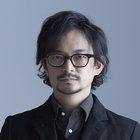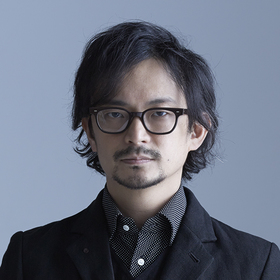Running counter to the present while thinking about the future: The style of Rhizomatiks' Daito Manabe
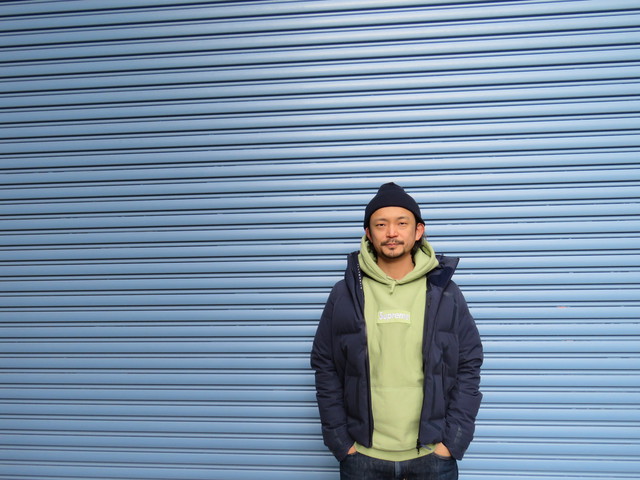
Precocious youth
Mr. Manabe, you have appeared in various forms of media and you are remarkably active, but I noticed from looking at several interview articles that your parents both worked in music. Do you think that had a big influence on Rhizomatiks and who you are today?
Manabe: I think so. My dad is a bassist and my mum was involved with synthesizer development at Yamaha, and there was always a lot of musical equipment at our home. From around second grade in elementary school, I started making simple sounds using these pieces of equipment as toys.
Also, when we were living in America, I came across an action game called Frogger on the Atari VCS (an early home videogame console that was released in America in 1977), and ever since then I've been a slave to videogames. Even after returning to Japan, my first creative activity came about because I used to go and play at the videogame arcade in Shibuya Tokyu Bunka Kaikan (a building located in the space where Shibuya Hikarie is today) on my way to and from lessons, and the sounds I remembered there I would try to replicate at home using synthesizers. I also had a desire to produce actual games, so I used to make my own game books and code programs on a computer that my parents had bought for me. I think that was the starting point. I was making what would today be described as musical games.
The first beatmania game was released in 1997, so you must have been really ahead of the curve. [Laughs]
Manabe: I was in fifth grade, so yes, I might well have been! [Laughs] After that, going into junior high school, I started watching MTV at home, and I became attracted to American street culture through western music and rap, and by the time I was in third grade at junior high I was already going to clubs. Do you know Chocolate City in Yoyogi?
I know that place! I've never actually been to it, though.
Manabe: This was right about the time of the second-generation Japanese rap boom, with EAST END fronting and Rhymester in the background. As a junior high school student wanting to DJ there, adults were only too happy to show me the ropes. After that I really became obsessive about DJing, and during my university years I would be DJing about six times a week. I used to work on events related to advertising, I signed a contract with an agent in America and ended up playing in front of crowds of about 10,000 people as the backing DJ of foreign artists, and I was able to experience really large-scale venues in this way. Looking back on that time, I'll never forget the scenes I saw and the feeling of such huge sound pressure. I think that in some ways I'm still working in entertainment today.
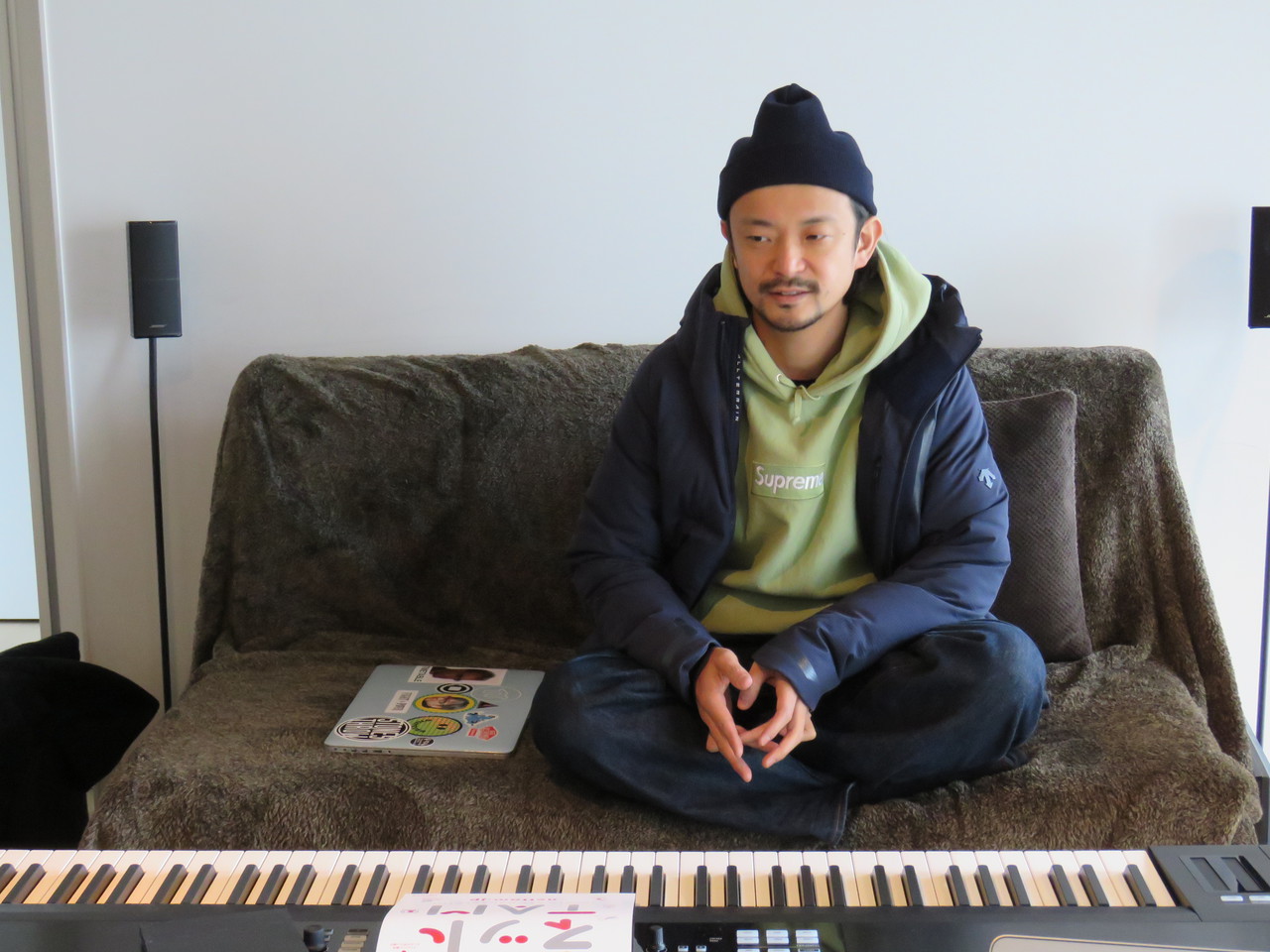
New encounters with sound
What was it that first brought you into contact with art?
Manabe: I was attending the Department of Mathematics at Tokyo University of Science. There were many interesting people in the Architecture Department, such as 000studio's Mr. Shohei Matsukawa. Those guys teamed up with Dumb Type's Mr. Ryoji Ikeda to produce music for exhibitions, but one time Mr. Ikeda was unavailable, so I got the call to produce surround sound source noise using eight speakers across sound sources.
When playing as a DJ or in a band, the style was such that the impact of sound output was everything, but Mr. Matsukawa and his team requested music that emphasized concepts such as "we want music that will make the space itself calm". At first, I approached this scientifically, thinking that "if you want a quiet room, silence will be the best method!" [Laughs] But when I learned about the music of Erik Satie and John Cage, I was shocked to find a style of music that is a counterpoint to human psychology. That was my cue.
After entering IAMAS (Institute of Advanced Media Arts and Sciences, which turns out many internationally active artists and engineers) in Gifu Prefecture, I spent a while making sound works that were basically copies of Mr. Ikeda's stuff. Happy days. [Laughs]
So sound is at the starting point...
Manabe: That's right. It basically began with sound. That's why even now, I'm not particularly picky about image-based expression.
And yet your full debut piece, 2008's "Electric Stimulus to Face", is a work that has a strong physical sense, forcibly operating facial expressions using myoelectric sensors. I sense some distance between this work and music...
Manabe: Yes, but that was also born from an extension of sound art. There were many pioneers of works whose success depends on sound output from speakers, Mr. Ikeda included. So then I started thinking about the speaker itself, and I was constantly carrying out experiments to turn my house into a speaker by installing a huge oscillator in my home.
It's really interesting how the low frequency waves emitted by an oscillator affect the human body! For example, you become unable to wink, or unable to breathe, or it makes you want to go to the toilet. And that's what led to "Electric Stimulus to Face".
And because this work generated buzz on YouTube, your name and that of Rhizomatiks became recognized internationally...
Manabe: Another major factor came one year prior to that, with the experience of "true/honto no koto" (2007), which was produced by Mr. Takayuki Fujimoto and Mr. Takao Kawaguchi of Dumb Type. Also, in the prototype of that piece, which was called "Tablemind" (2006), Mr. Kawaguchi said that "We want to produce a dance where muscles are active even though from the outside it appears as though nothing is moving" - but if that alone were the case, then you wouldn't sense any changes when looking in from outside. So I suggested an idea where sound would be produced through sensing muscle contraction as a trigger, which is what we produced.
Also after that, I worked on many contemporary dance productions with Mr. Kawaguchi, Mr. Tsuyoshi Shirai and Monochrome Circus, but these often demanded continuous abstract music rather than the beat-based music that I like, so I felt that I wanted to try something a bit different. In which case, it might have been better for me to dance.
You personally?!
Manabe: Yeah, because I don't consider dancing with a disciplined body to be a requirement of dance. But at the time, you know, it was a bit embarrassing for me to dance. [Laughs] Moving my facial muscles, though? Yes, I could do that! That was a motivating factor in the production of "Electric Stimulus to Face". While the project started from sound, the ideal medium with which to embody that concept was the human body and dance using the human body. I think this expression is continuing even now.
What is the originality that Rhizomatiks possesses?
One of the characteristics of your activity is the way in which you broadly open up to the public your production processes and programs. Where does such an awareness of commonality come from?
Manabe: In terms of productions, this originated with "Perfume Global Site" (2012), which was opened to the public as a second-generation production using motion-capture data from Perfume dances. Even before then, I had been developing with open source tools and opening up to the public some of the source code that I had written, but the idea of sharing or opening like that is a really common thing in the Internet communities I was involved with since my youth, so it's not like I particularly set out to do something new.
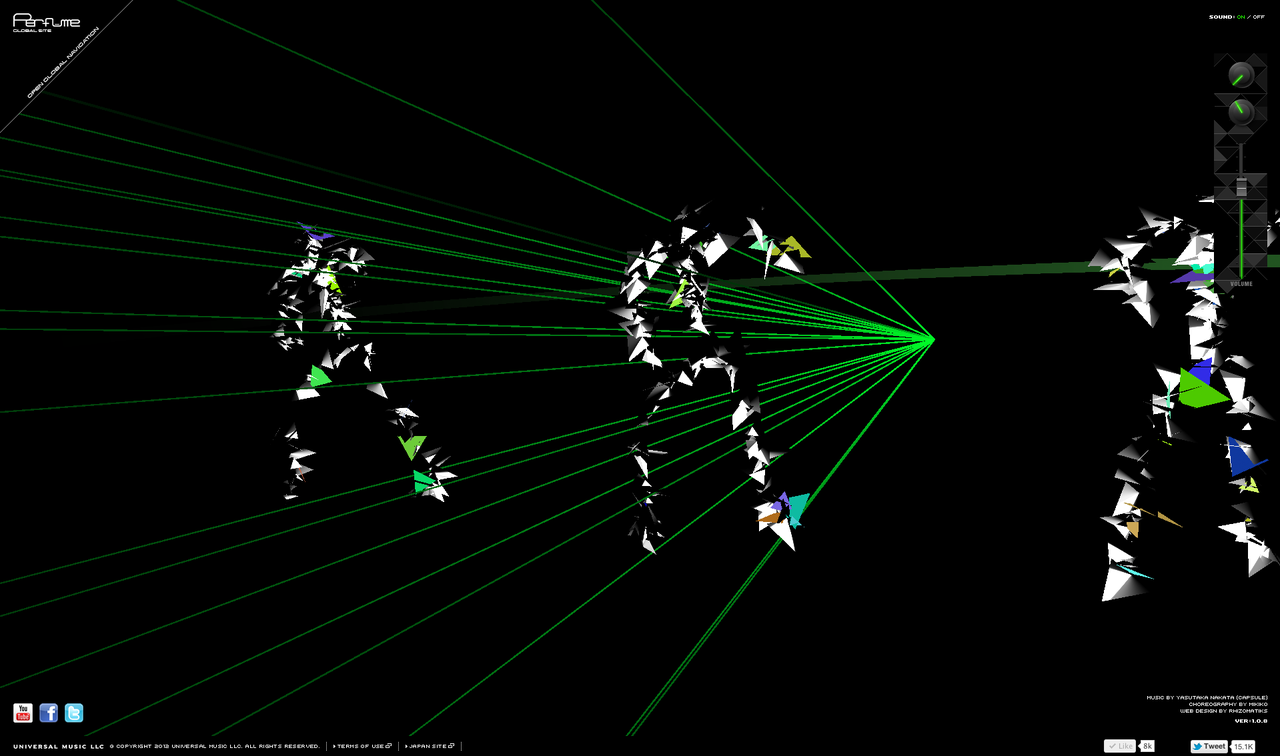
+Perfume "Global Project #001"
(2012 copyright: Amuse Inc. and Rhizomatiks Co.,Ltd, Universal Music LLC,)
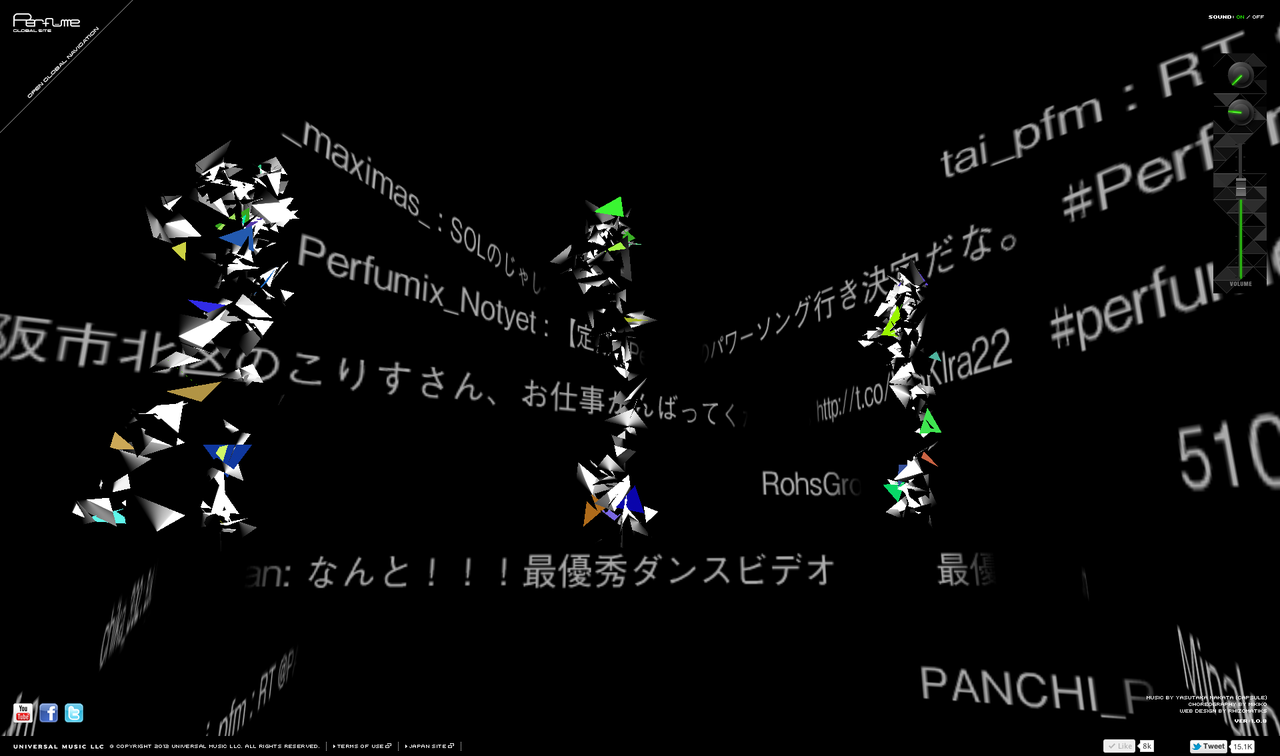
+Perfume "Global Project #001"
(2012 copyright: Amuse Inc. and Rhizomatiks Co.,Ltd, Universal Music LLC,)
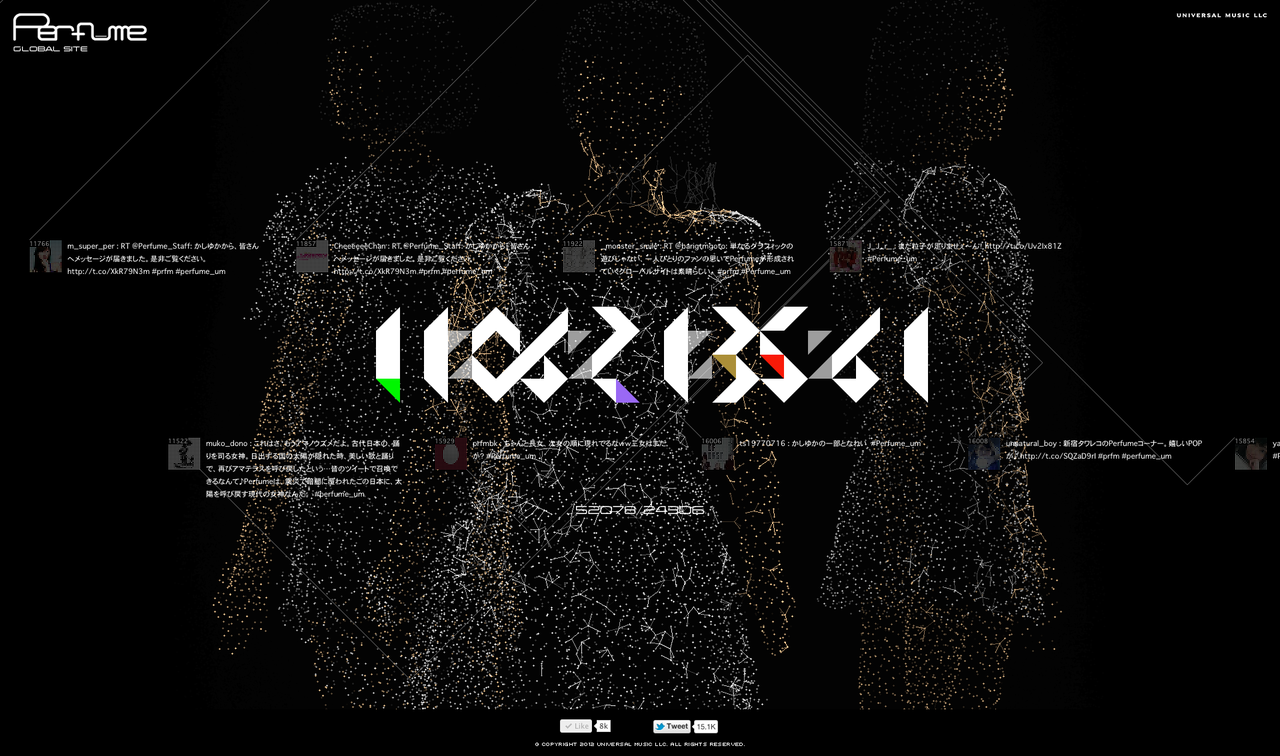
+Perfume "Global Project #001"
(2012 copyright: Amuse Inc. and Rhizomatiks Co.,Ltd, Universal Music LLC,)
I get the impression that you and Rhizomatiks are from the same era in terms of your activities and how you bring together many forms of creativity and skill while adopting the ethos of a field that has a relatively short history, yet without relying on specifically individual artistic sense.
Manabe: Yes, because there's no way that one person alone can produce a movie or a performance work. I think that at the core of Rhizomatiks' activity is that it brings together staff who possess high levels of expertise individually and can share their values. There people who have a scientific leaning, others who are focused on the arts, and still others with high levels of production capability. Without such an organization, it would be impossible to deal with many diverse projects, and it wouldn't be any fun because you would get swallowed up in competition with variations on the visual expression trends of the time. As far as we're concerned, we want to stand or fall on how interesting our ideas and constructions are.
In that sense, Rhizomatiks tends to be thought of as a modernistic production group, but I think that it's actually going against the grain. Our works are not very efficient, nor is it easy to monetize the things we produce. [Wry smile] So in terms of company organization we've got it all wrong. In America, performances are produced through endless subdivision of tasks - this company takes care of LED, that company deals with textiles, and so on. But I think that it's surely not possible to fully taste the joy of creativity in a situation like that. That's why we're careful not to pursue "optimization".
To run away from optimization while looking towards high-end technology is a unique stance, isn't it?
Manabe: That's why we operate at a much quicker speed and higher quality than internationally famous companies. But if we're considering monetization alone, then I think it would be best if we just worked on visuals. [Laughs]
So your high level of mobility is what ensures that Rhizomatiks can stay ahead. However, are you not also afraid of being swallowed up by large organizations that are making up ground?
Manabe: I've recently started to feel this way a little, but most of those organizations seem to be churning out inferior copies, so they're not such a big threat. In fact, I think we're probably the only ones who are producing shows where dancers and drones are brought together indoors. Also, in terms of our high level of mobility, we could say that it's typical of Rhizomatiks to be receiving work for the Olympics while at the same time entering "America's Got Talent". [Laughs]
That's the public audition show that's so popular in America, right? So you entered this show, which provides a gateway to fame for unknown talents, as Rhizomatiks?
Manabe: Exactly. If we had won twice more, we would have received a prize of 100 million yen, but unfortunately we had to pull out because it coincided with the Rio Olympics performance.
The interesting thing about Rhizomatiks is that it receives work from clients while at the same time producing not-for-profit works. Even if there are no requests, Rhizomatiks repeats proprietary experiments.
Manabe: The good thing about art projects is that it's okay even if tangible results cannot be obtained, or even if what you're making changes into something completely different partway through. In terms of a manufacturer, it's a bit like research and development. It's not just about researching and developing: experiments also need to be carried out to check that the production deliver proper strength. We don't want to give up the freedom of setting our own goals and hurdles. Because we cannot have 100% freedom in work for clients, where people other than ourselves ultimately have the right to judge our work. In my mind, art and entertainment have their own clearly defined distinctions.
Learning about and communicating history
Within that, was the performance at the closing ceremony of the Rio Olympics not a really unique piece of work for Rhizomatiks to take on? With live performances or commercials you can think about the needs of a limited set of fans or clients, but at the Olympics, which is a special event on an international scale, you need to substitute that for an unbelievably broad concept taking in nations and races...
Manabe: Communicating a message through performance rather than through visuals was difficult because it became a really abstract form of expression. The catch copy clearly stated what Japan wanted to convey, but we couldn't use language to do it. So it was our responsibility to convert language into an abstract, non-lingual form of expression. On the site of the production process, there were exchanges where we'd say "this won't convey the message" ...and then... "but if we explain everything up to this point, that's not going to look good". It was difficult to make decisions because there were more people than usual involved in this project.
Were there also technological hurdles?
Manabe: Actually, that side of things went pretty smoothly. Because, you know, we had already had many experiences of developing productions for arenas and stadiums, so we knew full well the problems that could occur and how to avoid them. It's more of an engineering problem than a creative issue, and the key was the extent to which we could avert risk in advance. Organizations that can get it perfectly right are few and far between, and the fact that Rhizomatiks was able to deal with this shows that these results could only be obtained through our work.
On the other hand, I'm frustrated that because of the bureaucracy relating to the Olympics, we're not able to open to the public our production expertise as we have done previously. If we could publicly release information like we have done until now, we would be able to share with the whole world our experience of how to avoid unnecessary difficulties and accidents. We never wanted to monopolize this information. But while it does promote creativity, the unique structure of the Olympics is also a little constrained. That's something I'd like to see change in the future.
In terms of your outlook going forwards, how do you think the creative scene will change beyond the 2020 Olympics?
Manabe: To be honest, I'm not really thinking much about the future. [Laughs] But as I said before, I want to have a hand in changing the environment in which accumulation of R&D and production are hidden and not put to practical use.
To put it another way, I take it you mean the archiving and historical logging of technological history in relation to artistic expression. The feature article on Rhizomatiks carried in the Bijutsu Techo monthly magazine was particularly impressive, and you seem to be very conscious of inheriting history and connecting it to the future.
Manabe: That's because it's important to always make a situation where one can command a view of history for the sake of one's own activities. Also, simply put, history is interesting because it's kind of like searching for the roots of hip-hop material. [Laughs] For example, at the Rio Olympics, I directed the production of various effects using rectangular models, and going back in history, there were similar techniques in Bauhaus or even in circus juggling. So our originality in this performance was that we produced a frame as an interface to bring out into the real world virtual world objects that were not visualized, to which we added choreography. By inspecting history in a detailed way like this, existing forms of expression can be updated to suit the present time. I think that's a major role of artists as historical beings.
At the same time, you are actively taking part in communicating technologies and thinking to the next generation - a good example would be the workshops you run for junior high school students...
Manabe: Ever since I started working with Perfume, I've been swamped by emails from junior high school and high school students. Stuff like "I want to make it so that Perfume will seem to be dancing when I point my camera at the QR code on this New Year's card". That's quite an interesting idea, and it's cute, isn't it?
It's great that junior high school students have that enthusiastic fan mentality. [Laughs]
Manabe: The source code to make that possible was published online, so I replied to emails and explained how to get it. Actually, some of the junior high school students with whom I had such exchanges are now enrolled at Keio University's Showa Fujisawa Campus, and are involved with some excellent activities.
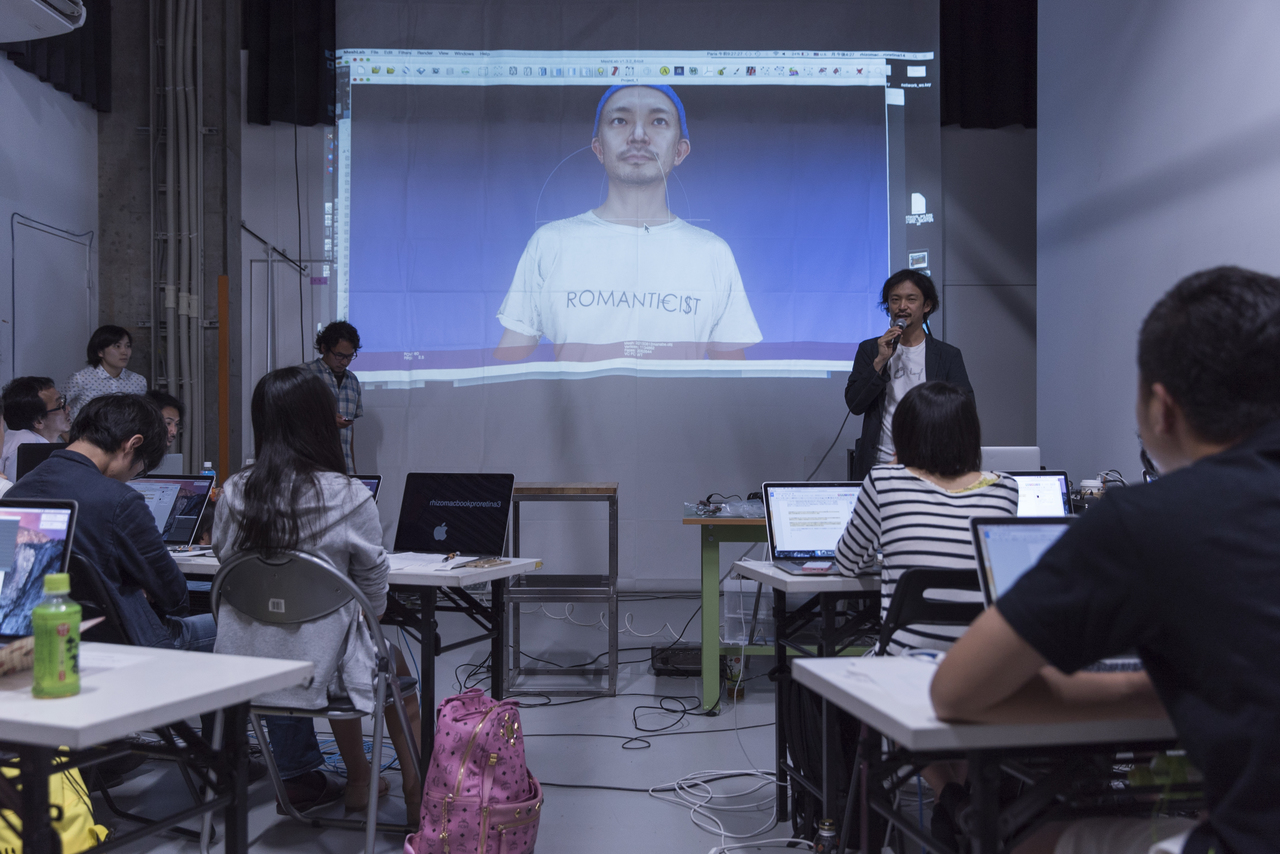
photo by Muryo Homma(Rhizomatiks Research)
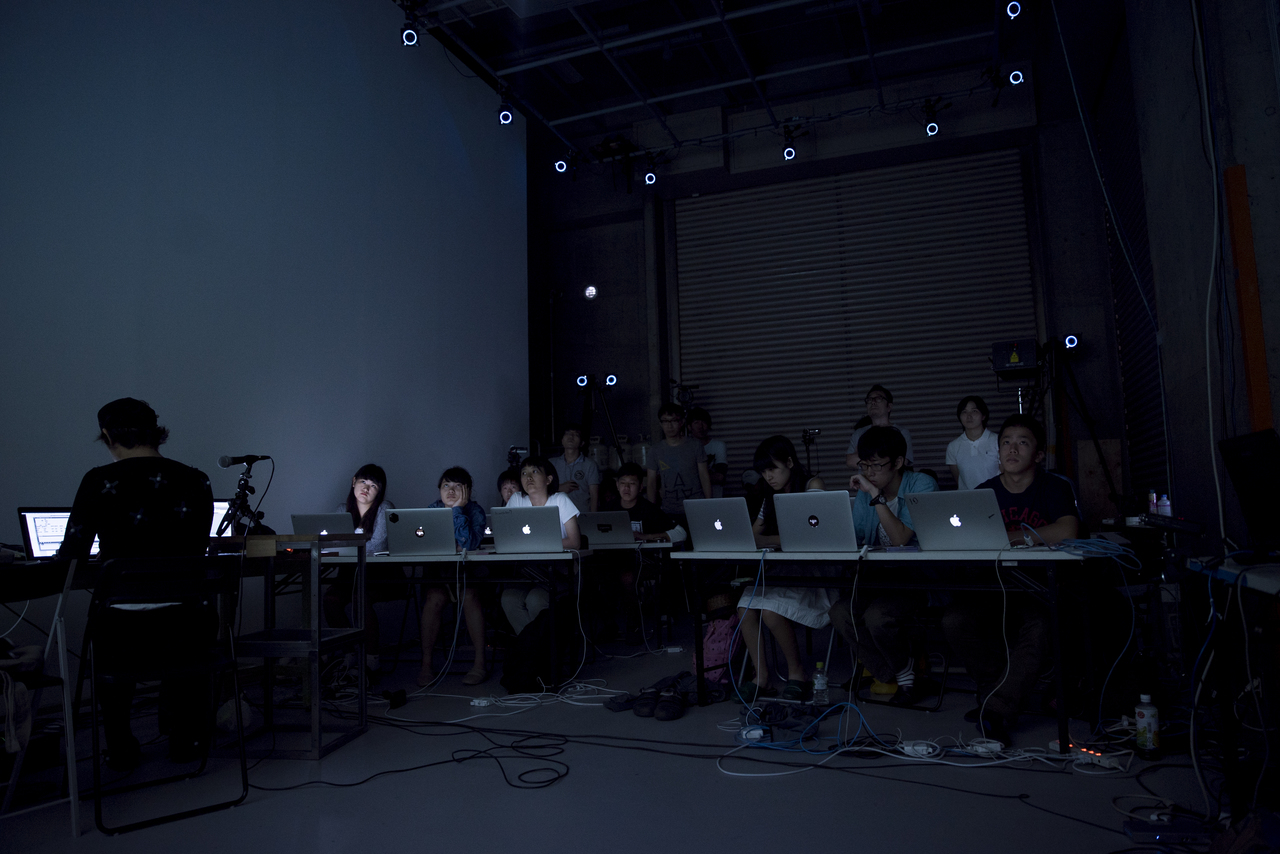
photo by Muryo Homma(Rhizomatiks Research)
So you have a teacher-and-student relationship. [Laughs]
Manabe: But if it were just a case of direct transmission, it wouldn't be an efficient exercise, so I select kids who seem to have potential to take part in the workshops. And I think it's good if those children can further expand the technology. It's an initiative that started from an individual activity, but quite a few people seemed to find it interesting and picked it up in their programs. Going forwards, I want to develop the framework so that it can be shared a little more widely.
I had various starting points, but one of the big things was becoming interested in mathematics at an early age. That's why I want people to have various experiences at junior or senior high school age, before they start to think of mathematics as a drag. And I want them to make something for themselves. The workshop incorporates such wishes.
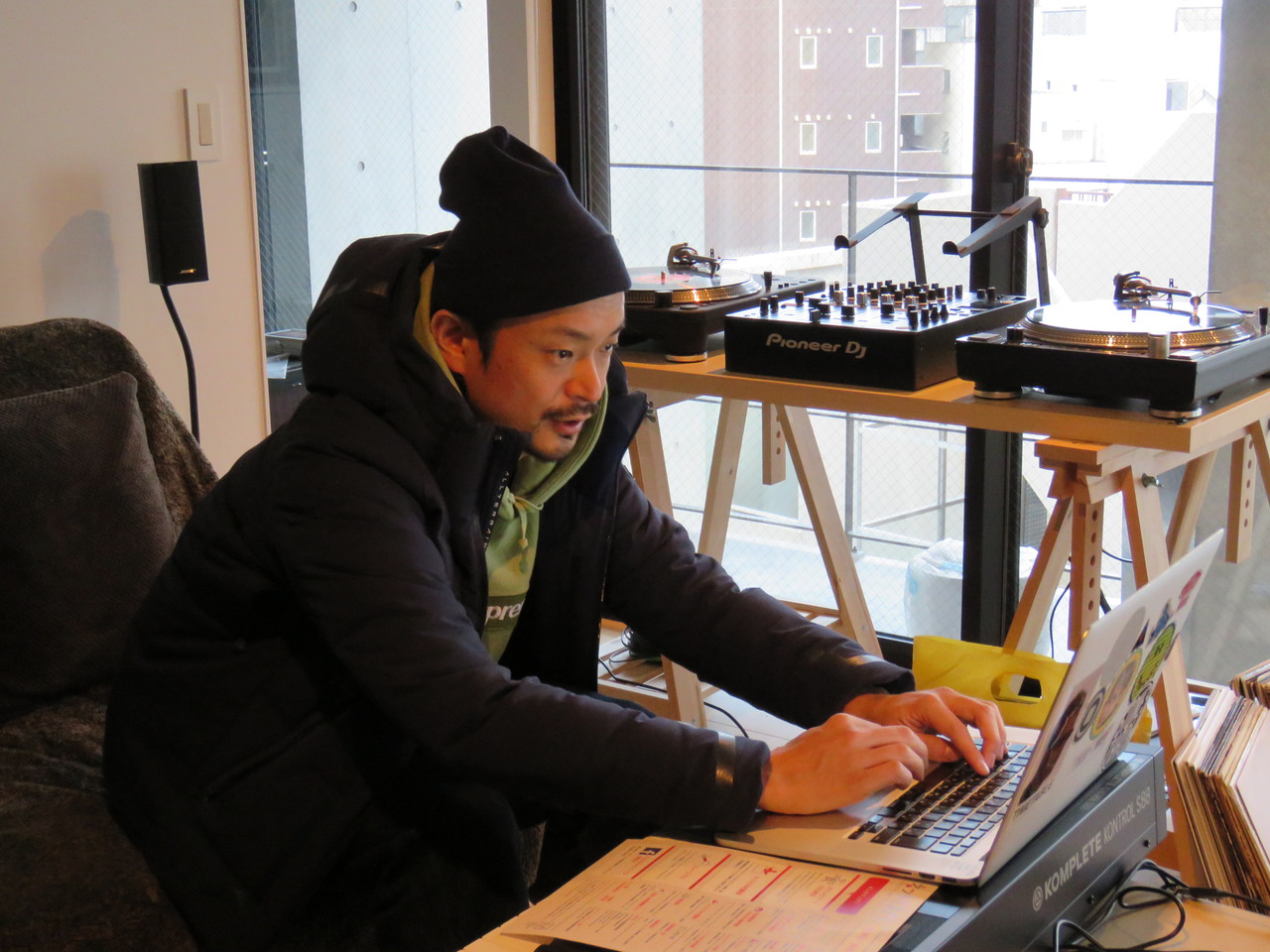
Coverage outline
- Coverage date: February 24, 2017
- Coverage location: Rhizomatiks Co., Ltd.
- Subject of coverage: Daito Manabe , President of Rhizomatiks Co., Ltd.
- Coverage and organization: Taisuke Shimanuki
- Reporter: Taisuke Shimanuki, NetTAM Management Office (Kyoko Uchida, Toyota Motor Corporation; Kanako Sato, Association for Corporate Support of the Arts; Takuya Irie)


